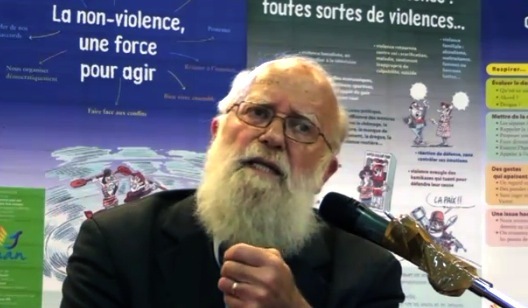Nonviolence in Education
by Jean-Marie Muller

Photo, Jean-Marie Muller; courtesy histoiresordinaires.fr
On 10 November 1998, the General Assembly of the United Nations proclaimed the period 2001–2010 “the International Decade for a Culture of Peace and Nonviolence for the Children of the World” (Resolution 53/25). The General Assembly considered that “a culture of peace and nonviolence promotes respect for the life and dignity of every human being without prejudice or discrimination of any kind.” It furthermore recognised the role of education “in constructing a culture of peace and nonviolence, in particular the teaching of the practice of peace and nonviolence to children, which will promote the purposes and principles embodied in the Charter of the United Nations.” The General Assembly went on to invite member states to “take the necessary steps to ensure that the practice of peace and nonviolence is taught at all levels in their respective societies, including in educational institutions.” There may well be good reason to celebrate the fact that the representatives of the member states assembled in New York voted for such a resolution, but nonviolence is still alien to the culture we have inherited. The core concepts around which our thought is organised and structured leave little room for the idea of nonviolence; violence, on the other hand, is inherent in our thinking and behaviour. Nonviolence is unexplored territory. Our minds have such trouble grasping the concept of nonviolence that we are often inclined to deny its relevance. So a great deal of educational work remains to be done to prevent the United Nations resolution from going unheeded, and to ensure that the “culture of peace and nonviolence” to which it refers really does change the mindset of teachers and children.
On 14 May 1985, in a “Recommendation to Member States”, the Council of Europe had already made the case for education in nonviolent conflict resolution. It maintained that, “concepts associated with human rights can and should be acquired from an early stage. For example, the nonviolent resolution of conflict and respect for other people can already be experienced within the life of a preschool or primary school class.” And it went on to list a number of the skills needed to understand and uphold human rights, which included: knowing how to recognise and accept differences; how to establish constructive and non-oppressive relationships with others; and how to resolve conflict in a nonviolent manner.
Civilisation, according to the philosopher Karl Popper, essentially consists in reducing violence. This, in Popper’s view, should be the main aim of democracy. Individual liberty can only be guaranteed in society when every member gives up the use of violence: the rule of law calls for nonviolence, which is one of its essential elements. If any given individual uses violence against another, it becomes necessary for the government to step in to restore public safety and social peace. Popper, however, believed that the rule of law must be based not on state repression, but on people being public-spirited enough to give up violence of their own accord. Before that can happen, a culture of nonviolence needs to be fostered among the citizens, and the first step to take is to teach children about nonviolence. The more the duty to teach nonviolence is neglected, Popper claims, the greater the hold of the culture of violence over society and the greater the government’s need for recourse to restrictive and repressive measures. Education consists not just in teaching the facts but also, and above all, in showing how important it is to eliminate violence.
Children, when all is said and done, must be educated in nonviolence. For that to happen, however, the education itself must first of all draw on the principles, rules and methods of nonviolence: nonviolence in teaching is the first step to teaching nonviolence. Érick Prairat, echoing Georges Gusdorf’s assertion that violence is akin to a below-the-belt blow to the honour of philosophy, considers violence to be akin to a below-the-belt blow to the honour of education. Adults must respect the child’s world and not seek to invade and brutally occupy it by imposing their laws and ideologies. Writing in 1929, Janusz Korczak, a pioneer of education based on respect for the child, highlighted how children were being kept in subjection by adults: “We know the roads to prosperity, give direction and advice. We develop virtues, suppress faults. We guide, correct, train. The child — nothing. We — everything. We order about and demand obedience. Morally and legally responsible, wise and farseeing, we are the sole judges of the child’s actions, movements, thoughts and plans. We give instructions and supervise the execution. Depending on will and understanding: our children, our property.” Nowadays, we have understood that such a domineering approach is not the best way for adults to teach little human beings about responsibility and freedom. A child has a right to respect because he or she is already a person.
Read the complete text of the article, as a searchable pdf file, by clicking here: Nonviolence in Education.
EDITOR’S NOTE: Jean-Marie Muller is a founding member of the Movement for a Non-Violent Alternative (MAN), and Director of Studies at the Research Institute on the Non-Violent Resolution of Conflicts (IRNC). As a writer he has published many books on nonviolence, many of which are now recognized as standard reference works. These include: Le principe de non-violence [The principle of non-violence] (Paris: Desclée de Brouwer, 1995), Gandhi l’insurgé [Gandhi the insurgent] (Paris: Albin Michel, 1997) and Le courage de la non-violence [The courage of non-violence] (Paris: Editions du Relié, 2001). An English translation of Le principe de non-violence has just been released as The Principle of Nonviolence: a Philosophical Path, Honolulu: Center for Global Nonkilling, 2014. Muller’s own website (in French) can be found at this link. His French Wikipedia page is also informative.




